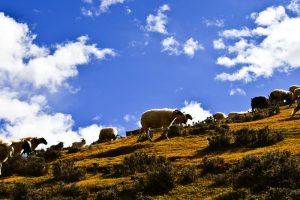
22 Days Western Tibet Tour from Kathmandu
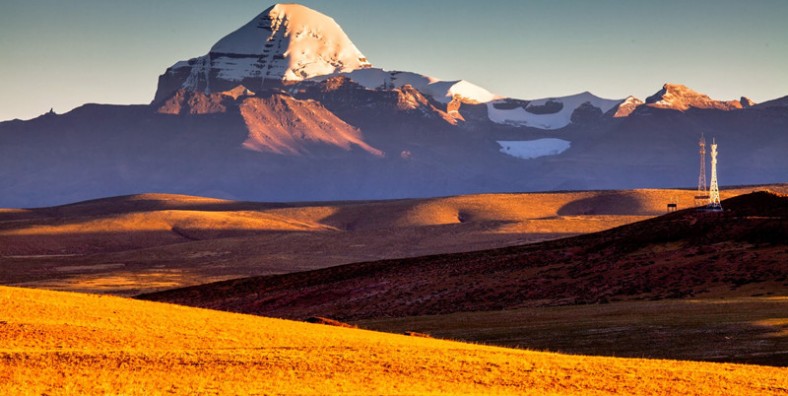
Tour Overview
Nepal is the transportation hub of south Asia, and there are a large number of tourists who enter Tibet from Nepal. As long as tourists have long holidays, they...
Code of Tour: YCT0000003542
Length of Travel: 22 Day
Destinations of Tour: Kathmandu-Lhasa-Namtso-Ali-Guge Kingdom-Darchen-Lake Manasarovar-Peiku-tso Lake-Zhangmu
Departure City: Kathmandu
Price of Tour: Request
Type of Tour:
Features of Tour: Nature Hiking Culture Minority Landscape
Nepal is the transportation hub of south Asia, and there are a large number of tourists who enter Tibet from Nepal. As long as tourists have long holidays, they can add Mt. Kailash in western Tibet to their plan and make a long itinerary staring from Lhasa to Shigatse city, Mt. Everest, Mt. Kailash, and leave Tibet from the Sino-Nepal border which is not far away from Mt. Kailash. This 22 days Western Tibet Tour from Kathmandu was chosen by a great number of independent travelers for many attractions along the way. Travelers will have varied experience of Himalaya Mountain Range, Glaciers, Monasteries, wildlife, vast lands, holy lakes and sacred places.
Highlights:
- Enjoy the city highlights of Kathmandu and fly from Kathmandu to Lhasa and drive back to Kathmandu after the tour;
- Experience the Tibetan Buddhism in the main monasteries in Lhasa city and along your way;
- Visit the top lakes and grassland in Tibet-Namtso, Peikutso Lake and Changtang Grassland;
- Trekking 3 days the most sacred and mythical mountain in the world-Mt. Kailash;
- Meet snown mountains, tranquil lakes, shimmering rivers, Tibetan villages and rare animals on your way.
Brief Itinerary
- Day 1: Kathmandu Arrival
- Day 2: Kathmandu
- Day 3: Kathmandu-Lhasa
- Day 4: Lhasa
- Day 5: Lhasa
- Day 6: Lhasa-Namtso
- Day 7: Namtso-Bange
- Day 8: Bange-Nyima
- Day 9: Nyima-Gertse
- Day 10: Gertse-Ali
- Day 11: Ali-Zanda
- Day 12: Guge Kingdom
- Day 13: Zanda-Darchen
- Day 14: Darchen-Drirapuk
- Day 15: Drirapuk-Dzutrpuk
- Day 16: Dzutripuk-Darchen
- Day 17: Darchen-Lake Manasarovar
- Day 18: Lake Manasarovar-Saga
- Day 19: Saga-Zhangmu
- Day 20: Zhangmu-Kathmandu
- Day 21: Kathmandu
- Day 22: Kathmandu Departure
Google Map
Detailed Itinerary
Day 1 Arrive in Kathmandu, Visit Kathmandu Durbar Square
Sightseeing and Activities:Durbar Square
Accommodation:Kathmandu
Meals:None
Upon your arrival, our local guide will meet you at the airport and take you to your hotel. After a little rest, we go to visit the Durbar Square. The Durbar Square lies in the heart of Kathmandu. Known as Hanuman Dhoka by locals, Palace Square is the ancient seat of the Nepalese Royalty. Most of the buildings seen here date from 15th to 18th century. Some of the important monuments are: Taleju temple, Jagannath temple, Kal Bhairav, Kumari Ghar, Kasthamandap – built from the timber of a single tree. Stay overnight in Kathmandu.
Day 2 Kathmandu Day Tour
Sightseeing and Activities:Pashupatinath Temple, Boudhanath Stupa and Swayambhunath stupa
Accommodation:Kathmandu
Meals:Breakfats, Lunch
In the morning, first drive to Pashupatinath Temple which is situated 5 kilometers east of Kathmandu City and one of the holiest temples dedicated to Lord Shiva. Then we continue driving to Boudhanath Stupa, 8 kilometers east of Kathmandu City. Boudhanath Stupa is one of the biggest stupas of its kind in the world. After lunch, drive to Swayambhunath Stupa, located approximately 4 kilometers west of Kathmandu city. This Buddhist Stupa is said to be 2000 years old. Stay overnight in Kathmandu.
Day 3 Fly to Lhasa & Acclimate the Elevation of Lhasa
Sightseeing and Activities:Fly to Lhasa
Accommodation:Lhasa
Meals:Breakfats, Lunch
Take a flight to Lhasa. Upon your arrival, your local tour guide will pick you up at the airport and escort you to your hotel in Lhasa. The rest of the day is for you to explore the city freely so as to adapt yourself to the high altitude of Lhasa. Stay overnight in Lhasa.
Day 4 Lhasa
Sightseeing and Activities:Potala Palace, Jokhang temple, Barkhor Street
Accommodation:Lhasa
Meals:Breakfast, Lunch
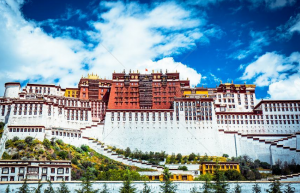
Today’s tour will first bring you to the Potala Palace, the winter palace of the Dalai Lama. It has been used since the 7th Century by the 33rd great king of Tibet. The most valuable collection are the gilded burial stupas of past Dalai Lamas and meditation Cave of the 33rd great king of Tibet.
After you take lunch and then head to Jokhang Temple which was founded by the 33rd great king of Tibet in the 7th century, in order to promote the Buddhist religion. Inside you can see the statue of Buddha Sakyamuni at the age of twelve, perhaps the single most venerated object in Tibet Buddhism.
Around the temple Barkhor Street where you can do kora (circling the Barkhor street) with pilgrims and locals and buy the souvenirs. Stay overnight in Lhasa.
Day 5 Lhasa
Sightseeing and Activities: Drepung Monastery, Carpet factory, Sera Monastery
Accommodation:Lhasa
Meals:Breakfast, Lunch
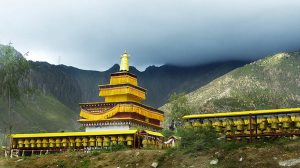
In the morning, you are going to visit Drepung Monastery which was one of the “three greet” Gelug monasteries of Tibet and was founded in 1416 by Jamyang choge, one of the Tsongkhapa’s main disciples. Ganden palace is used as Dalai lama’s palace in the Drepung before moving to the Potala palace.
Afternoon, Sera Monastery—It was one of the “three great” Gelug monasteries of Tibet and was founded in 1419 by Jamchen chojey, one of the Tsongkhapa’s main disciples. The highlight is the Monks debate at around 3 – 5 in the afternoon. Stay overnight in Lhasa.
Day 6 Drive to Namtso Lake (220km, 4hrs driving, asphalt road in good condition)
Sightseeing and Activities:Nyenchen Thanglha snow mountain, Namtso Lake
Accommodation:Namtso Guest House
Meals:Breakfats, Lunch
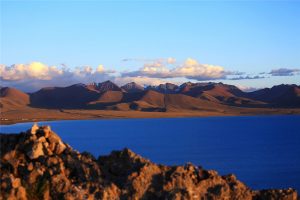
At around 08:00am, our guide and driver will pick you up from your hotel, and then drive to Namtso Lake. Nyenchen Thanglha Snow Mountain ranges appear in front of you all the way. In summer (May to August), the sheepherders and their family move to grassland and set up their tents. You could see green grassland, groups of sheep and yaks, nomad tents by the road. Namtso Lake is the heavenly lake which is one of the three holy lakes of Tibet and also the highest salt lake. You can do a very relax trekking around the lake side and Tashi Island. To spend a night at lake shore is fantastic. The night sky is so clean that you could see all the stars twinkling in the sky, so close to you as if you could stretch your hands to pick the stars. Situated at about 5000m high, Namtso Lake is actually the lake in the sky, lying on the highest plateau in the world. Stay overnight at Lake Shore (Tent Guest House, dorm bed).
Day 7 Drive to Bange (150km)
Sightseeing and Activities:Namtso Lake, Tashi Dor Island
Accommodation:Bange Camp or Guest House
Meals:Breakfats, Lunch
While enjoying the clear morning at the lake shore, you can trek along the lake shore to Tashi Dor Island to explore the meditation caves. Then drive to Bange. Stay overnight in Bange (Camp or Guest House).
Day 8 Drive to Nyima (330km)
Sightseeing and Activities:Chiangtang grassland
Accommodation:Camping
Meals:Breakfats, Lunch
Drive to Nyima passing through the Chiangtang Grassland and stretching west to Ali (also Shiquanhe). The road condition is quite poor, but it is flat and is being improved now. It would be rare to meet people on the way for you are driving through ‘Tibetan Northern uninhabited region’. Today you will see different kinds of wild animals, small lakes, vast grasslands and deserts. Stay overnight at Nyiam (Camp).
Day 9 Drive to Gertse (326km): The Uninhabited Area
Sightseeing and Activities:the uninhabited area
Accommodation:Camping
Meals:Breakfats, Lunch
Continue driving along the Amdo-Shiquanhe road about 326km to Gertse. Today, you will drive through the uninhabited area and the grasslands, the gobi, swamps and deserts. Stay overnight at Gertse (Camp).
Day 10 Drive to Ali (506km):Mt. Kailash and Lake Manasarovar
Sightseeing and Activities:Mt. Kailash and Lake Manasarovar
Accommodation:Ali Guest House/Camping
Meals:Breakfats, Lunch
Today is a long driving day. But our destination will provide you with better dining and accommodation condition than the former two days. The world-renown Mt. Kailash and Lake Manasarovar are located in this thinly populated area. Stay overnight in Ali (Guest house/Camp).
Day 11 Drive to Zanda (310km)
Sightseeing and Activities: Clay Forest, Guge Kingdom
Accommodation:Zhada Guest House/Camping
Meals:Breakfats, Lunch
Drive southeast to Zhada and pass Laochi-la and Lalung-la Pass over 5000m. The road is very tough as the vehicle heads towards this area. Zanda means a downstream place of grassland. Animal husbandry and agriculture is well developed in this county. The earth forest, also called clay forest and Guge Kingdom are the most famous tourist spots in Zanda County. Stay overnight at Zhada (Guest House/Camp).
Day 12 Sightseeing at Guge Kingdom
Sightseeing and Activities:Sightseeing at Guge Kingdom
Accommodation:Zanda Guest House
Meals:Breakfats, Lunch
In the morning, we drive to Tsaparang (Guge Kingdom, 23km), and drive back to Tholing by the evening. Guge Kingdom is one of the first important cultural relic sites under protection, the grand palace ruins stand on a 300-meter tall yellow earth hill on the banks of the Xiangquang River in the Zaborang District. Stay overnight at Zhada( Guest House, dorm bed).
Day 13 Drive to Darchen (250 Km)
Sightseeing and Activities:Tirthapuri hot-spring
Accommodation:Darchen
Meals:Breakfats, Lunch
Drive from Zhada to Darchen. You will have a chance to have Tirthapuri hot-spring on the way. Prepare for trekking. Darchen was previously known as Lhara and still signposted as such. It was previously an important sheep station for nomads and their flocks and had only two permanent buildings; only one of which survived the Cultural Revolution and is now used to house Tibetan pilgrims. Stay overnight at Darchen (Guesthouse).
Day 14 Trek day one (Outer circuit) – Darchen to Drirapuk – 11km
Sightseeing and Activities:Trek day one (Outer circuit) – Darchen to Drirapuk – 11km
Accommodation:Camping
Meals:Breakfats, Lunch
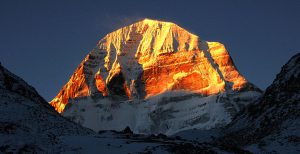
Traditionally, pilgrims undertake 52 km trekking circuit around Mount Kailash, commencing at Darchen (4574m) and crossing the Dolma-la Pass on the second day of the three day walk. Darchen is the starting and completion point for the general circuit of the sacred mount. A few kilometers after leaving Darchen, tourists will see a valley called “Sarshung” where porters are waiting for their clients. They will help the clients to take every necessary thing on yaks and horses. After two hours, you come upon a grassy plain populated by nomads. There you can refresh yourself in nomadic tent and drink some soft drinks there. For this turn in the valley it is another two hours at least before reaching Drirapuk(4920m). You need to camp or can rest in monastery’s guest house made from cement with a few good facilities than others in Drirapuk. At the opposite side of Drirapuk, there you can see small monastery with its guest house little cleaner than others. Camping.
Day 15 Trek day two – Drirapuk to Dzultripuk – 22km
Sightseeing and Activities:Lhachu valley
Accommodation:Camping
Meals:Breakfats, Lunch
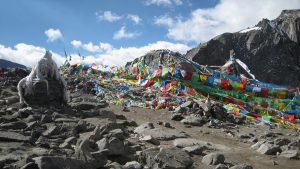
The second day is the hardest and most tough circuit with the Dolma-la Pass lying 6.4km ahead but 762m above Drirapuk. The peak of Dolma-la pass is about 5630m above sea level, so it is better to set off early in the morning as the sun rays break over the ridges above. After taking a rest at the peak of Dolma-la pass, you will decend to Lhachu valley floor via staircase, which takes about one hour from the pass. From here it is still four hours trekking to the today’s final destination with no shelters on the way. It is better to walk on the right side of the river and finally get to Dzultripuk (with miracle cave of milarepa). It is advisable to get there before other groups’ arrival because the number of rooms available is limited there in Dzultripuk. Take a good rest in the guest room and prepare for next morning’s departure. Camping.
Day 16 Trek day three- Dzultripuk to Darchen – 11km:Milarepa’s cave
Sightseeing and Activities: Trek day three- Dzultripuk to Darchen – 11km:Milarepa’s cave
Accommodation:Darchen
Meals:Breakfats, Lunch
The tour guide will arrange you to visit the caves, the temple and shrines that have been built around Milarepa’s Cave. Then walk back to Darchen is easy and the exit from the valley can be reached within three hours. At the ending point of the valley, the driver will come to pick you and take you back to Darchen. Stay overnight in Darchen.
Day 17 Darchen to Lake Manasarovar (60km, 2hours)
Sightseeing and Activities:Lake Manasarovar
Accommodation: Chiu Monastery Guest House
Meals:Breakfats, Lunch

In the morning, we drive to the holy Lake Manasarovar (4558m). The rest of the day is at leisure. You can relax around the lake shore and experience the natural beauty of the lake. In summer, flocks of swans will gather on the lake, bringing grace and life to the area. You can also see so many Tibetans and Hindus praying and circling around the lake shore for the whole day, snow capped mountains on the background and hundreds of swans gathering on the lake, attracting hundreds and thousands of tourists from all over the world. Stay overnight at Chiu Monastery (Guest house, dorm bed).
Day 18 Lake Manasarovar-Paryang-Saga (506km, 7-8hrs driving)
Sightseeing and Activities:Lake Manasarovar-Paryang-Saga (506km, 7-8hrs driving)
Accommodation:Saga
Meals:Breakfats, Lunch
In the morning, starting from the beautiful lake, we drive about 4 hours to Paryang (4700m). You will be shocked by the fabulous view of distant mountains, yak herders camp, if lucky enough, you might come across a herd of Kyang (Wild Ass). After having lunch at Paryang, we continue heading to Saga through the windswept territory passing many villages and camps of Yak herders with the distant view of snow capped mountains. This vast and dry plateau is the traditional campsite of the nomads, grazing their animals during the summer. Stay overnight at Saga.
Day 19 Saga – Peiku-tso Lake – Zhangmu
Sightseeing and Activities:Himalaya Mountains, Peiku-tao Lake
Accommodation:Zhangmu
Meals:Breakfats, Lunch
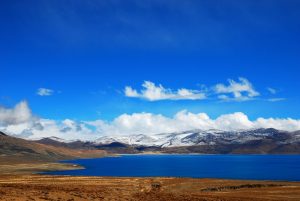
Today, we will drive to the stunning alpine lake, Peiku-tso for Lunch. An amazing picture of the lake with Shishapangma in the background will come into your sight when you arrive there. After lunch, we keep driving to Zhangmu. Today’s driving is amazing with excellent views of Himalaya Mountains, a lot of wildlife including wild horses, wolves, foxes, deer, gazelle, black-necked cranes as well as yaks and sheep. Stay overnight in Zhangmu.
Day 20 Gyirong Port to Kathmandu
Sightseeing and Activities:Gyirong Port to Kathmandu
Accommodation:Kathmandu
Meals:Breakfats, Lunch
It takes about 5 hours to complete 130km rough asphalt road from Gyirong Port to Kathmandu. Your Tibetan tour guide will see you off at the Chinese Border, and your Nepalese tour guide will take care of your Nepal tour. Stay overnight in Kathmandu.
Day 21 Free Day in Kathmandu
Sightseeing and Activities:Free Day in Kathmandu
Accommodation:Kathmandu
Meals:Breakfats, Lunch
After a long trip, you may feel exhausted, today is at leisure for you to have a good rest or to explore Kathmandu’s narrow, bustling streets lined with small shops and restaurants. Stay overnight in Kathmandu.
Day 22 Depart from Kathmandu
Sightseeing and Activities: Depart from Kathmandu
Accommodation:None
Meals:Breakfats
After a good rest in Kathmandu, today it’s time to part with Kathmandu and get transferred to airport for the flight.
Recommended Hotels
| Destination | 5 Star | 4 Star | 3 Star |
| Lhasa | Luxury St. Regis Lhasa Resort | Lhasa Gang Gyan Hotel | Lhasa Xiongbala Hotel |
| Ali | / | Huahui Yintai Hotel | Ali Yinghe Hotel |
| Zanda | / | / | Yadu Hotel |
| Darchen | / | / | Darchen New Hotel |
| Saga | / | Xibu Yizhan Hotel | Brahmaputra Hotel |
| Zhangmu | / | / | Zhangmu Jiaotong Hotel |
Service Included:
- Admission fees for all of the sightseeing spots listed in the itinerary;
- Meals as listed in the itinerary;
- Accommodation with breakfast as listed in the itinerary;
- Private English-speaking tour guide and vehicle for transfers & sightseeing;
- Service charge & government taxes;
- Luggage transfers between airports and hotels;
- Two bottles of mineral water each day.
Service Excluded:
- Any arrival and departure international airfares or train tickets;
- Chinese visa fees;
- Excess baggage charged by Airlines;
- Single room supplement;
- Tips to guides and drivers;
- Personal expenses and gratuities to service staff;
- Personal travel insurance;
- All optional programs;
- Domestic air tickets fares with airport tax and fuel extra fee based on economy class mentioned in the program.
Travel Tips:
- Tibet Permits
There are several permits required to visit Tibet. Tibet Entry Permit, issued by Tibet Tourism Bureau, is the most important one which has to be obtained before your trip because you must have it to take your flight/train to Tibet. To get the permit, you have to book a Tibet tour with us, and send us your passport and Chinese visa about 20 days in advance, and then let us apply for the permit (all Tibet permits can only be applied by travel agency). If you travel to other prefectures like Shigatse, Nyingchi, Shannan, etc, you also have to obtain an Alien Travel Permit. If you travel to Mount Everest, you have to obtain a Border Permit. (Tibet Discovery, with office in Lhasa, has always kept up with the latest news on Tibet Permits. Traveling with us, all your permits are guaranteed as long as you are qualified to the requirements.)
- Available Months to Visit Tibet
Generally speaking, May to early October is the best time to for a Mount Kailash trip. July and August are the peak season and rainy season. It may be too cold to travel in Kailash area from November to March. There is usually heavy snow. The conditions in Namtso Lake and Mount Everest area are quite similar with Kailash. While other places like Lhasa, Gyantse and Shigatse are suitable for travel all year around.
- High Altitude Sickness
The average altitude of Tibet is about 4000 meters above the sea level (Lhasa: 3700m; EBC: 5200m; Namtso: 4718m). You may suffer a bit from High Altitude Sickness in the beginning days of your Tibet trip if you haven’t had rich high plateau travel experience. But don’t worry too much, the high altitude can be acclimatized usually in 2~3 days. Our suggestion is to take a physical examination and get suggestions from your doctor, and also bring some medicines to prevent from High Altitude Sickness before your trip. While in Tibet, you should keep warm all the time, avoid strenuous activities, drink more water and eat more vegetables and carbohydrates. You’d better not take showers during the first two days after your arrival at Tibet. If you don’t feel well, get help from your tour guide or go to the hospital without any delay.
- How to Go to Tibet
Basically you have two options – flight and train. Currently, you can take a flight to Lhasa from Beijing(4.5hrs), Xian(3.7hrs), Chengdu(2.5hrs), Chongqing(3hrs), Kuming(3hrs), etc. Among all these cities, Chengdu and Xian have more frequent flights to Lhasa. Kathmandu also has several flights to Lhasa each week.
If you a train travel, you can take a train to from Beijing(40.5hrs), Xian(32hrs), Chengdu(43hrs), Shanghai(47hrs), Chongqing(42hrs), Lanzhou(25hrs), Xining(22hrs), Guangzhou(54hrs).
- Packing and Wearing Ideas
Firstly you can’t forget your passport and Chinese Visa. A large backpack and a smaller one are recommended (the smaller one can be used for daily activities). Also bring the necessary medicine you need. Other stuffs like sunglasses, snow glasses, hats, lip balm, sun block are recommended. As for wearing, you are suggested to dress in layers (both thin and thick jackets). Down jacket is necessary in Spring and Autumn. A pair of durable and comfortable shoes is necessary.



